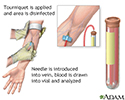Febrile (warm) and cold agglutinins
Cold agglutinins; Weil-Felix reaction; Widal test; Warm agglutinins; Agglutinins
Agglutinins are antibodies that cause the red blood cells to clump together.
- Cold agglutinins are active at cold temperatures.
- Febrile (warm) agglutinins are active at normal body temperatures.
This article describes the blood test that is used to measure the level of these antibodies in the blood.
How the Test is Performed
How to Prepare for the Test
There is no special preparation.
How the Test will Feel
When the needle is inserted to draw blood, some people feel moderate pain. Others feel only a prick or stinging. Afterward, there may be some throbbing where the needle was inserted.
Why the Test is Performed
This test is done to diagnose certain infections and find the cause of hemolytic anemia (a type of anemia that occurs when red blood cells are destroyed). Knowing whether there are warm or cold agglutinins can help explain why the hemolytic anemia is occurring and direct treatment.
Normal Results
Normal results are:
- Warm agglutinins: no agglutination in titers at or below 1:80
- Cold agglutinins: no agglutination in titers at or below 1:16
The examples above are common measurements for results of these tests. Normal value ranges may vary slightly among different laboratories. Some labs use different measurements or test different samples. Talk to your doctor about the meaning of your specific test results.
What Abnormal Results Mean
An abnormal (positive) result means there were agglutinins in your blood sample.
Warm agglutinins may occur with:
- Bacterial infections, including brucellosis, rickettsial disease, salmonella infection, and tularemia
- Viruses such as hepatitis C, COVID-19, HIV, and Epstein Barr virus (infectious mononucleosis)
- Inflammatory bowel disease
- Lymphoma
- Systemic lupus erythematosus
- Use of certain medicines, including methyldopa, penicillin, and quinidine
Cold agglutinins may occur with:
- Bacterial infections, such as Mycoplasma pneumoniae, Listeria monocytogenes, and Legionella pneumophila
- Cancer, including lymphoma and multiple myeloma
- Systemic lupus erythematosus
- Viruses such as chicken pox (varicella), cytomegalovirus, Epstein Barr virus (infectious mononucleosis), hepatitis B, and hepatitis C
- Waldenström macroglobulinemia
Risks
Risks are slight but may include:
- Excessive bleeding
- Fainting or feeling lightheaded
- Hematoma (blood accumulating under the skin)
- Infection (a slight risk any time the skin is broken)
Considerations
If a disease linked to cold agglutinin is suspected, the person needs to be kept warm. If you have cold or warm agglutinin disease, you may need treatment for your hemolytic anemia.
References
Elghetany MT, Banki K. Erythrocytic disorders. In: McPherson RA, Pincus MR, eds. Henry's Clinical Diagnosis and Management by Laboratory Methods. 24th ed. Philadelphia, PA: Elsevier; 2022:chap 33.
Goldman DL. Mycoplasma infections. In: Goldman L, Cooney KA, eds. Goldman-Cecil Medicine. 27th ed. Philadelphia, PA: Elsevier; 2024:chap 293.
Michel M, Jäger U. Autoimmune hemolytic anemia. In: Hoffman R, Benz EJ, Silberstein LE, et al, eds. Hematology: Basic Principles and Practice. 8th ed. Philadelphia, PA: Elsevier; 2024:chap 47.
Quanquin NM, Cherry JD. Mycoplasma and ureaplasma infections. In: Cherry JD, Harrison GJ, Kaplan SL, Steinbach WJ, Hotez PJ, eds. Feigin and Cherry's Textbook of Pediatric Infectious Diseases. 8th ed. Philadelphia, PA: Elsevier; 2019:chap 196.
Review Date: 6/11/2024











